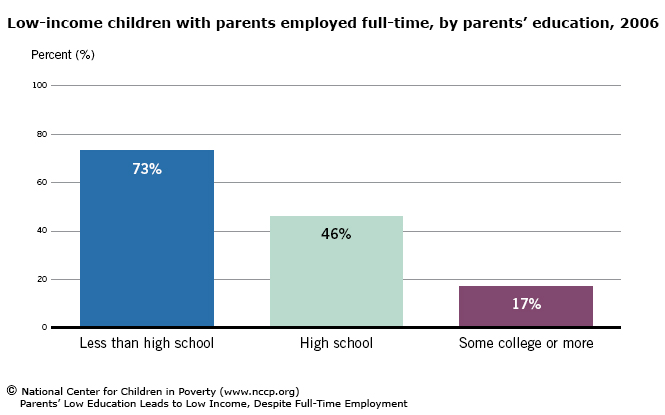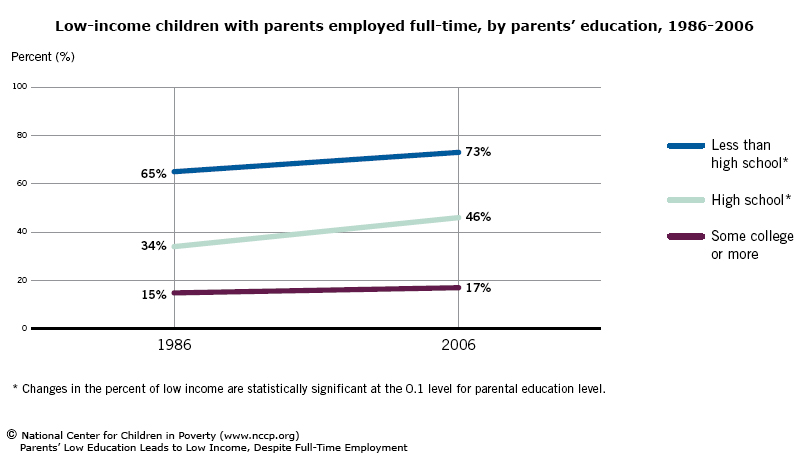Higher education is one of the most effective ways that parents can raise their families’ incomes. There is clear evidence that higher educational attainment is associated with higher earnings. Over the past two decades, parents with less education have been losing economic ground. Policies that support education for low-income parents and children offer them the potential for lasting economic security.
The majority of children in low-income families have parents without any college education.
- 25% of children in low-income families – almost 7.2 million – have parents with less than a high school diploma.
- 36% – over 10.3 million – have parents with a high school diploma, but no college education.
- 39% – over 11.0 million – have parents who have at least some college education or more.
Higher education leads to higher earnings.
- 82% of children whose parents have less than a high school diploma live in low-income families.
- 57% of children whose parents have a high school diploma, but no college education, live in low-income families.
- Only 24% of children whose parents have some college education or more live in low-income families.
If parents have low education levels, full-time employment does not protect their families from low earnings.

Among children whose parents work full-time and year-round:
- 73% of children whose parents have less than a high school diploma live in low-income families.
- 46% of children whose parents have a high school diploma, but no college education, live in low-income families.
- Only 17% of children whose parents have some college education or more live in low-income families.
Parents with less education are losing economic ground.

Over the past two decades, children with parents employed full-time are increasingly likely to be low income if their parents do not have at least a college education. Among children whose parents work full-time and year-round:
- The percent of children in low-income families increased from 65% to 73% if parents had less than a high school diploma.
- The percent of children in low-income families increased from 34% to 46% if parents had a high school diploma, but no college.
- The percent of children in low-income families increased from 15% to 17% if parents had some college education or more.
Policy Implications
Federal and state policies offer opportunities to make higher education more accessible to low-income parents.
- Increase access to financial aid for low-income students. Over the past decade, federal resources for higher education have primarily benefited higher-income families. However, recent legislation seeks to reverse this trend by expanding federal grants to low- and middle-income students. Supporting these changes can reduce financial barriers to schooling and increase access to higher education for low-income parents
- Help low-income parents who are enrolled in higher education with child care costs. Many states do not provide subsidies for parents who are pursuing higher education. Increasing funds for child care subsidies and expanding eligibility criteria helps parents who need affordable, stable arrangements for their children while they are in school.
- Head Start can promote the pursuit of higher education among the next generation of parents. Low-income children who attend Head Start are more likely to graduate from high school and attend college. Protecting the funding and high standards of Head Start will ensure that more low-income children are able to pursue higher education – and the economic security that comes with it.
Endnotes
This fact sheet is part of the National Center for Children in Poverty’s demographic fact sheet series and is updated annually. This is the 2007 edition. Estimates were prepared by Ayana Douglas-Hall and Michelle Chau, based on the data calculated from the U.S. Current Population Survey, Annual Social and Economic Supplement, March 2007, representing information from the previous calendar year. Estimates include children living in households with at least one parent and most children living apart from both parents (for example, children being raised by grandparents). Children living independently, living with a spouse, or in group quarters are excluded from these data. Children ages 14 and under living with only unrelated adults were not included because data on their income status were not available. Among children who do not live with at least one parent, parental characteristics are those of the householder and/or the householder’s spouse.
1. Low income is defined as twice the federal poverty level or $41,300 for a family of four in 2007. More information about federal poverty measures is available at U.S. Department of Health and Human Services.
2. Parental education is defined as the education level of the most highly educated parent who lives with the child.
3. Parental employment is the employment level of the parent in the household who maintained the highest level of employment in the previous year. Parents can either have no employment in the previous year, part-year or part-time employment, or full-time, year-round employment. Part-year or part-time employment is defined as either working less than 50 weeks in the previous year or less than 35 hours per week. Full-time, year-round employment is defined as working at least 50 weeks in the previous year and 35 hours or more per week for more than half the year.
4. Maag, E. & Fitzpatrick, K. (2004). Federal financial aid for higher education: Program and prospects. Washington, DC: Urban Institute.
5. Schemo, Diana J. (2007). Congress passes overhaul of student aid programs. New York Times. September 8, 2007.
6. Garces, E.; Duncan, T.; & Currie, J. (2000). Long-term effects of Head Start (NBER Working Paper No. 8054). Cambridge, MA: National Bureau of Economic Research.
